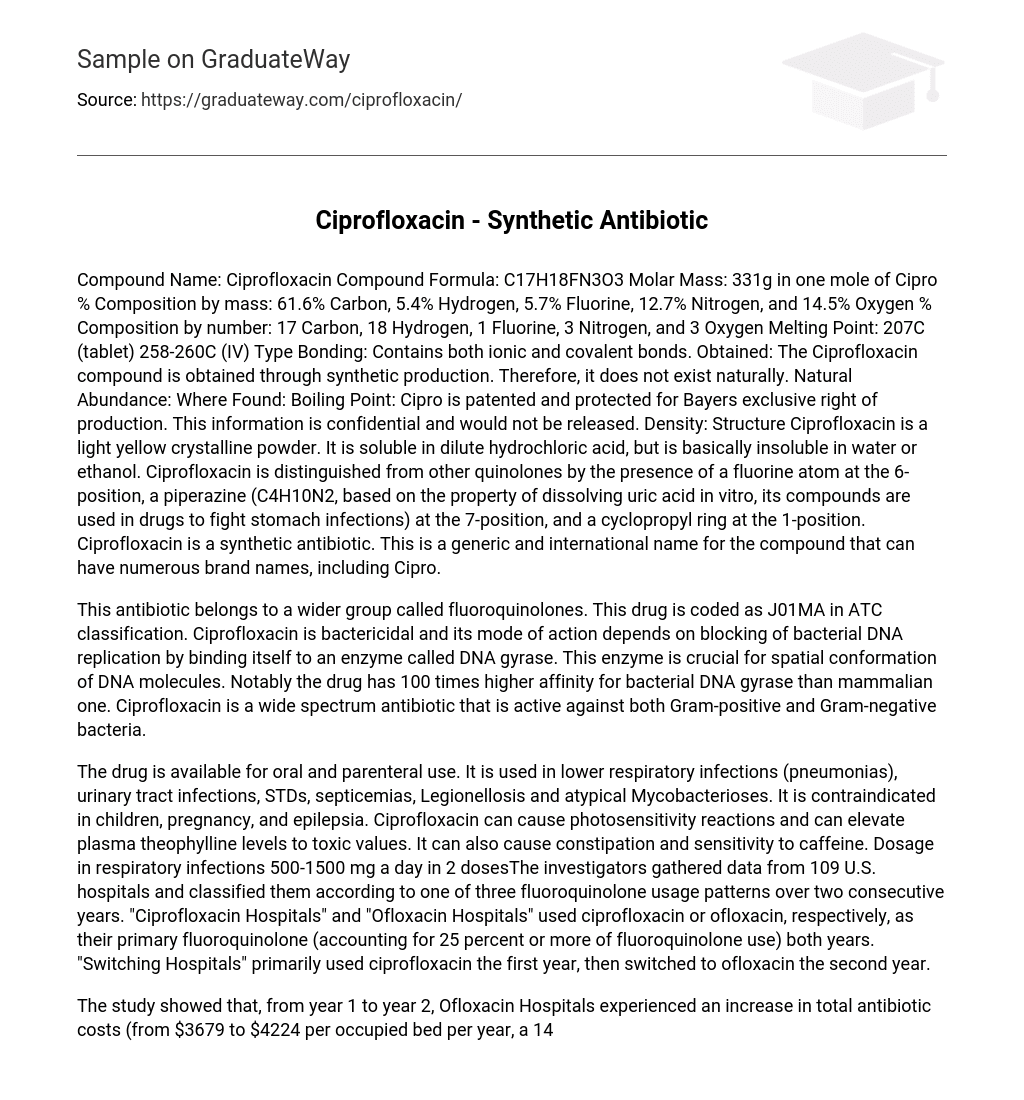History of UseBayer Corporation, a research-based pharmaceutical company with major businesses in health care and life sciences, sponsored the study. Bayer manufactures Cipro (ciprofloxacin HCl) Tablets, Cipro IV (ciprofloxacin) and Cipro (ciprofloxacin) Oral Suspension. Cipro Tablets and Cipro IV is the leading fluoroquinolone antibiotic worldwide. It has been available to fight serious urinary and respiratory tract infections due to susceptible organisms for 12 years with proven efficacy and safety. Cipro was the first systemically active fluoroquinolone with a broad spectrum of indications, including urinary, respiratory tract, skin and skin structure, bone and joint and intra-abdominal infections.
Structure Ciprofloxacin is a light yellow crystalline powder. It is soluble in dilute hydrochloric acid, but is basically insoluble in water or ethanol. Ciprofloxacin is distinguished from other quinolones by the presence of a fluorine atom at the 6-position, a piperazine (C4H10N2, based on the property of dissolving uric acid in vitro, its compounds are used in drugs to fight stomach infections) at the 7-position, and a cyclopropyl ring at the 1-position. Ciprofloxacin is a synthetic antibiotic. This is a generic and international name for the compound that can have numerous brand names, including Cipro.
This antibiotic belongs to a wider group called fluoroquinolones. This drug is coded as J01MA in ATC classification. Ciprofloxacin is bactericidal and its mode of action depends on blocking of bacterial DNA replication by binding itself to an enzyme called DNA gyrase. This enzyme is crucial for spatial conformation of DNA molecules. Notably the drug has 100 times higher affinity for bacterial DNA gyrase than mammalian one. Ciprofloxacin is a wide spectrum antibiotic that is active against both Gram-positive and Gram-negative bacteria.
The drug is available for oral and parenteral use. It is used in lower respiratory infections (pneumonias), urinary tract infections, STDs, septicemias, Legionellosis and atypical Mycobacterioses. It is contraindicated in children, pregnancy, and epilepsia. Ciprofloxacin can cause photosensitivity reactions and can elevate plasma theophylline levels to toxic values. It can also cause constipation and sensitivity to caffeine. Dosage in respiratory infections 500-1500 mg a day in 2 doses.
The investigators gathered data from 109 U.S. hospitals and classified them according to one of three fluoroquinolone usage patterns over two consecutive years. “Ciprofloxacin Hospitals” and “Ofloxacin Hospitals” used ciprofloxacin or ofloxacin, respectively, as their primary fluoroquinolone (accounting for 25 percent or more of fluoroquinolone use) both years. “Switching Hospitals” primarily used ciprofloxacin the first year, then switched to ofloxacin the second year.
The study showed that, from year 1 to year 2, Ofloxacin Hospitals experienced an increase in total antibiotic costs (from $3679 to $4224 per occupied bed per year, a 14.8 percent increase) that was five times the increase experienced by Ciprofloxacin Hospitals (from $3892 to $4010 per occupied bed per year, a 3.0 percent increase).
Ofloxacin Hospitals also showed an increase in costs for fluoroquinolones ($304 to $408 per occupied bed per year, a 34.2 percent increase) that was four times the increase reported by Ciprofloxacin Hospitals ($342 to $371 per occupied bed per year, an 8.5 percent increase). Expenditures for non-fluoroquinolone anti-pseudomonal antibiotics increased by 11 percent for Ofloxacin Hospitals ($810 to $899 per occupied bed per year), but actually decreased by 5.5 percent for Ciprofloxacin Hospitals ($879 to $831 per occupied bed per year). Switching Hospitals had no significant changes in antibiotic expenditures in year 2 compared to year 1.
The researchers also examined hospital-reported rates of fluoroquinolone resistant strains of P. aeruginosa. Of reporting hospitals, 80 percent of P. aeruginosa isolates were susceptible to ciprofloxacin while only 70 percent of P. aeruginosa isolates were susceptible to ofloxacin. Ciprofloxacin Hospitals had a significantly lower rate of ciprofloxacin resistance (19 percent) compared to Ofloxacin Hospitals (28 percent).
The authors noted that Switching Hospitals had a ciprofloxacin resistance rate (22 percent) similar to that of Ciprofloxacin Hospitals, probably because many Switching Hospitals were still using appreciable amounts of ciprofloxacin while in the midst of introducing ofloxacin in the second year, and so had antibiotic usage patterns similar to Ciprofloxacin Hospitals in both years.
Among all hospitals, increased expenditures for ciprofloxacin (corresponding to increased use) correlated with decreased pseudomonal resistance to ciprofloxacin. “Bacterial resistance is one of the most important and threatening problems concerning infectious diseases that we face today,” noted Dr. Paladino. “Our results suggest that wide spread use of ofloxacin can lead to increased pseudomonal resistance to ciprofloxacin, whereas continued use of ciprofloxacin results in comparatively lower rates of this type of resistance. This is an important consideration, along with our findings on cost, for hospitals in selecting fluoroquinolone antibiotics.”
The Clinical Pharmacokinetics Laboratory, Buffalo, New York, founded in 1972, was the first laboratory of its type in the world. The laboratory is part of a joint venture between the State University of New York, Buffalo School of Pharmacy and Millard Fillmore Hospitals. The laboratory conducts all areas of research from phase I – phase IV studies, as well as epidemiologic studies all over the U.S. and Canada. The laboratory started the Benchmarking Program in 1991, with 55 hospitals enrolled. Today, over 200 hospitals are enrolled in the Benchmarking Program and Database. These 200 hospitals are surveyed every year on antibiotic use and antibiotic resistance. The laboratory has a staff of approximately 100.





